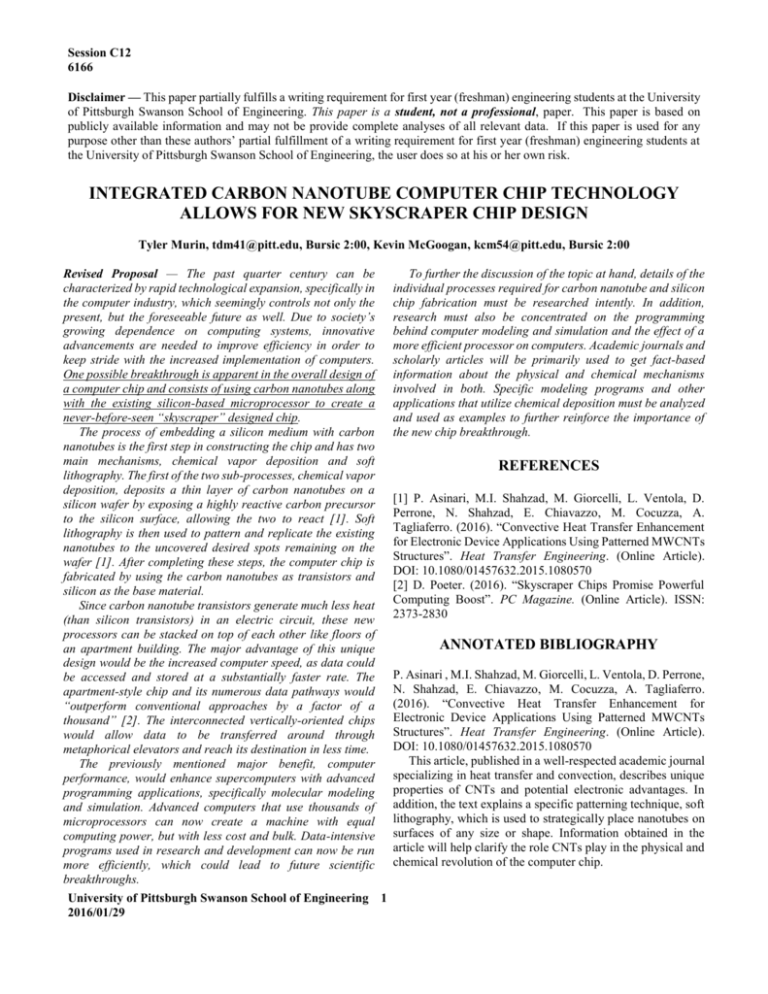integrated carbon nanotube computer chip technology allows for
advertisement

Session C12 6166 Disclaimer — This paper partially fulfills a writing requirement for first year (freshman) engineering students at the University of Pittsburgh Swanson School of Engineering. This paper is a student, not a professional, paper. This paper is based on publicly available information and may not be provide complete analyses of all relevant data. If this paper is used for any purpose other than these authors’ partial fulfillment of a writing requirement for first year (freshman) engineering students at the University of Pittsburgh Swanson School of Engineering, the user does so at his or her own risk. INTEGRATED CARBON NANOTUBE COMPUTER CHIP TECHNOLOGY ALLOWS FOR NEW SKYSCRAPER CHIP DESIGN Tyler Murin, tdm41@pitt.edu, Bursic 2:00, Kevin McGoogan, kcm54@pitt.edu, Bursic 2:00 Revised Proposal — The past quarter century can be characterized by rapid technological expansion, specifically in the computer industry, which seemingly controls not only the present, but the foreseeable future as well. Due to society’s growing dependence on computing systems, innovative advancements are needed to improve efficiency in order to keep stride with the increased implementation of computers. One possible breakthrough is apparent in the overall design of a computer chip and consists of using carbon nanotubes along with the existing silicon-based microprocessor to create a never-before-seen “skyscraper” designed chip. The process of embedding a silicon medium with carbon nanotubes is the first step in constructing the chip and has two main mechanisms, chemical vapor deposition and soft lithography. The first of the two sub-processes, chemical vapor deposition, deposits a thin layer of carbon nanotubes on a silicon wafer by exposing a highly reactive carbon precursor to the silicon surface, allowing the two to react [1]. Soft lithography is then used to pattern and replicate the existing nanotubes to the uncovered desired spots remaining on the wafer [1]. After completing these steps, the computer chip is fabricated by using the carbon nanotubes as transistors and silicon as the base material. Since carbon nanotube transistors generate much less heat (than silicon transistors) in an electric circuit, these new processors can be stacked on top of each other like floors of an apartment building. The major advantage of this unique design would be the increased computer speed, as data could be accessed and stored at a substantially faster rate. The apartment-style chip and its numerous data pathways would “outperform conventional approaches by a factor of a thousand” [2]. The interconnected vertically-oriented chips would allow data to be transferred around through metaphorical elevators and reach its destination in less time. The previously mentioned major benefit, computer performance, would enhance supercomputers with advanced programming applications, specifically molecular modeling and simulation. Advanced computers that use thousands of microprocessors can now create a machine with equal computing power, but with less cost and bulk. Data-intensive programs used in research and development can now be run more efficiently, which could lead to future scientific breakthroughs. University of Pittsburgh Swanson School of Engineering 1 2016/01/29 To further the discussion of the topic at hand, details of the individual processes required for carbon nanotube and silicon chip fabrication must be researched intently. In addition, research must also be concentrated on the programming behind computer modeling and simulation and the effect of a more efficient processor on computers. Academic journals and scholarly articles will be primarily used to get fact-based information about the physical and chemical mechanisms involved in both. Specific modeling programs and other applications that utilize chemical deposition must be analyzed and used as examples to further reinforce the importance of the new chip breakthrough. REFERENCES [1] P. Asinari, M.I. Shahzad, M. Giorcelli, L. Ventola, D. Perrone, N. Shahzad, E. Chiavazzo, M. Cocuzza, A. Tagliaferro. (2016). “Convective Heat Transfer Enhancement for Electronic Device Applications Using Patterned MWCNTs Structures”. Heat Transfer Engineering. (Online Article). DOI: 10.1080/01457632.2015.1080570 [2] D. Poeter. (2016). “Skyscraper Chips Promise Powerful Computing Boost”. PC Magazine. (Online Article). ISSN: 2373-2830 ANNOTATED BIBLIOGRAPHY P. Asinari , M.I. Shahzad, M. Giorcelli, L. Ventola, D. Perrone, N. Shahzad, E. Chiavazzo, M. Cocuzza, A. Tagliaferro. (2016). “Convective Heat Transfer Enhancement for Electronic Device Applications Using Patterned MWCNTs Structures”. Heat Transfer Engineering. (Online Article). DOI: 10.1080/01457632.2015.1080570 This article, published in a well-respected academic journal specializing in heat transfer and convection, describes unique properties of CNTs and potential electronic advantages. In addition, the text explains a specific patterning technique, soft lithography, which is used to strategically place nanotubes on surfaces of any size or shape. Information obtained in the article will help clarify the role CNTs play in the physical and chemical revolution of the computer chip. Tyler Murin Kevin McGoogan U. Cigdem, S. B. Kert, Z. Gecu. (2014). “Effectiveness of an Electronic Performance Support System on Computer Ethics and Ethical Decision-Making Education”. Journal of Educational Technology and Society. (Online Article). ISSN: 1436-4522. Published by an established peer review journal concentrating on advances in educational technology, this online article explains the conceptual aspects behind computer ethics. Methods to create and solve ethical scenarios are discussed thoroughly throughout the text and involve wellknown ethical decision making models, along with flowcharts and social experimentation. These techniques could be potential solutions to ethical issues that result from increased computing power caused by the skyscraper processor. T. Simmonite. (2014). “IBM: Commercial Nanotube Transistors Are Coming Soon.” MIT Technology Review. (Online Article). http://www.technologyreview.com/news/528601/ibmcommercial-nanotube-transistors-are-coming-soon/ Published in MIT’s technology review magazine, a renowned authority on innovation, the article discusses the urgency and importance behind the development of the carbon nanotube transistor. If CNT technology cannot be perfected within the next five years, global growth and expansion will slow, and current processor technology will not meet the demands of society. The article will be used to illustrate the importance of further research in the subject matter. “The Story of the Intel 4004”. Intel. (Online Article). http://www.intel.com/content/www/us/en/history/museumstory-of-intel-4004.html Obtained from the corporate website of Intel, an authority on microprocessor production, this article details the creation of the first functional computer chip. The basic chip components consisted of a central processing unit (CPU), readonly memory (ROM), random-access memory (RAM), and a shift register chip, all of which operated through integrated electronics. Original chip specifications will be used to emphasize how much processors have evolved and improved over time. S. Coulombe, M.A. McArthur, N. Hordy, S. Omanovic. (2015). “A binder-free multi-walled carbon nanotube electrode containing oxygen functionalities for electrochemical capacitors”. Electrochimica Acta. (Online Article). DOI: 10.1016/j.electacta.2014.09.019 The article was written and published by a reputable source, the official journal of the International Society of Electrochemistry, and discusses CNT growth techniques. The mechanisms involved in thermal chemical vapor deposition are analyzed, and benefits, such as increased CNT separation distance and bonding sites, are identified. This research will be vital in explaining how nanotube transistors will be grown on the silicon medium used in the skyscraper designed chips. B. Yirka. (2013). “Stanford researchers demonstrate carbon nanotube based computer chip.” Phys.org. (Online Article). http://phys.org/news/2013-02-stanford-carbon-nanotubebased-chip.html This online article, gathered from a web-based news service interested in science and technology, reinforces additional details of the skyscraper design. The idea that components of a processor can only be fabricated so small, along with the fact Stanford researchers produced a completely functional chip with CNTs, helped bring about the design. The article will be used to provide explanation of the chip’s design and reason for creation. “IBM Research- Almaden Science Colloquium Series”. International Business Machines (IBM). (Online Article). http://researcher.watson.ibm.com/researcher/view_group.php ?id=4284 Posted on the corporate website of IBM, a worldwide leader in computer hardware and software manufacturing, this article details research conducted by its lead employees. The research focuses on computational chemistry, in which reaction mechanisms are simulated by supercomputers, and collected data is used to improve efficiency of processes. This serves as an ideal application of an enhanced computer chip, as data collection and simulation times could be reduced significantly. D. Poeter. (2016). “Skyscraper Chips Promise Powerful Computing Boost”. PC Magazine. (Online Article). ISSN: 2373-2830 This professional article was published in an academic journal by an authority on computer technology and innovations. The main focus of discussion revolves around the skyscraper chip layout and schematic, which uses embedded CNT silicon chips and a vertically stacked orientation consisting of processors and memory modules. Overall, the article encapsulates the main topic of the paper and elaborates on a useful skyscraper analogy to further explain the chip’s function. 2








